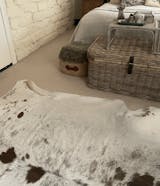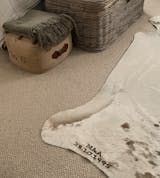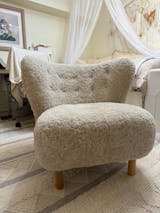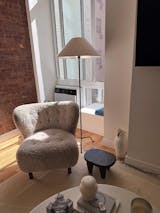
What is a Cowhide Rug? Unveiling the Beauty and Elegance: A Comprehensive Guide to Cowhide Rugs
alicia bengenShare
What is a Cowhide Rug?
Origin of Cowhide Rugs

- Historical Background
Cowhide rugs have been a popular choice for home décor for centuries, dating back to ancient civilizations. In the past, cowhide rugs symbolized wealth and status, often adorning the homes of nobility and high-ranking individuals. The historical significance of cowhide rugs adds a touch of tradition and cultural heritage to their modern-day appeal in the home.
In ancient times, cowhide rugs were not only practical but also held symbolic value for the home. Real cowhide rugs were used as decorative elements in homes and served as status symbols due to their rarity and durability. For example, in some cultures, these rugs were used to hide and signify power and prestige during important ceremonies reserved for royalty.
- Geographical Sources
Cowhide rugs are sourced from various countries around the world, each offering its own unique patterns and qualities. Popular sources include Brazil, Argentina, Colombia, India, among others. These different regions provide distinct characteristics for real cowhide rugs based on factors such as climate, breed variations, and traditional tanning methods.
For instance, Brazilian cowhide rugs are known for their softness and natural shine due to the specific cattle breeds found in the region. On the other hand, Argentinean cowhides are recognized for their larger size options with diverse color variations influenced by the country's grassy plains.
Cowhide Rug Production Process
- Selection of Hides
The cowhide rug industry relies on the careful selection of high-quality hides. Factors such as size, color, hair length, and the use of a real cowhide rug are crucial in this process. For instance, larger hides can be used to create bigger rugs, while smaller ones might be suitable for smaller decorative pieces. Imperfections like scars on a cowhide rug are often considered desirable as they add character to the final product.
During the selection process for creating a cowhide rug, it's essential to choose hides with unique patterns and colors that will contribute to the visual appeal of the finished rug. These distinct characteristics ensure that each cowhide rug is one-of-a-kind, everyone can find their perfect rug.
- Tanning and Dyeing
Once selected, the cowhide rugs undergo a tanning process that preserves their natural state while also ensuring durability and longevity. This step is vital in maintaining the quality of cowhide rugs over time.
Dyeing techniques are then employed to enhance color variations in the cowhide rug. This adds depth and richness to the final product by creating unique patterns or gradients within individual cowhide rug pieces. The combination of tanning and dyeing processes results in an array of visually striking cowhide rugs available on the market today.
- Final Shaping
After tanning and dyeing, cowhides are cut into desired shapes and sizes based on their intended use - whether it's a large area rug or a small accent piece. Furthermore, cowhide rug edges can be left natural for a more organic look or finished with stitching or binding for a polished appearance.
Customizable options allow consumers to have natural cowhide rugs tailored specifically to their preferences regarding shape, size, color scheme, and finishing details.
Ethical Considerations of Cowhide Rugs
- Sourcing Practices
Responsible suppliers prioritize animal welfare when sourcing cowhides. They adhere to industry standards that ensure the ethical treatment of animals, including the use of cowhide rugs. Transparency in the supply chain is crucial, allowing consumers to trace the origin of the cowhide and verify that it was ethically sourced.
For example, some suppliers work with ranches where cows are raised for meat production, ensuring that no cowhide rug animal is specifically killed for its hide. This practice of sourcing cowhide rugs aligns with ethical sourcing principles and promotes transparency within the supply chain.
- Animal Welfare
When considering cowhide production, it's essential to address ethical concerns regarding animal welfare. Proper treatment of animals during farming, including access to food, water, space for natural behavior, and cowhide rug is emphasized. Sustainable practices not only benefit the environment but also promote animal welfare by ensuring a healthy living environment for the cows, including the use of cowhide rugs.
For instance, some ranches implement rotational grazing methods that allow pastures to recover while providing fresh vegetation for cows. Additionally, these ranches often utilize cowhide rugs to add a touch of rustic charm to their spaces. Additionally, these ranches often utilize cowhide rugs to add a touch of rustic charm to their spaces. This approach supports sustainable land use and contributes to overall animal well-being, such as using cowhide rugs.
Durability and Quality
- Lifespan of Cowhide
Cowhide rugs are highly durable and can last for many years with proper care. Cowhide rugs are resistant to wear, tear, and fading, making them a long-lasting addition to any home. With regular maintenance such as vacuuming and occasional shaking out, these rugs maintain their natural beauty for a significant period.
For instance, if a cowhide rug is placed in an area with high foot traffic or exposed to direct sunlight regularly, it may show signs of damage sooner than one placed in a less-trafficked area or shielded from direct sunlight.
- Quality Assessment
The quality of cowhide rugs is assessed based on several factors including thickness, softness, and hair quality. Premium cowhide rugs boast uniform patterns with minimal flaws. Expert craftsmanship ensures that the end products, such as cowhide rugs, meet high-quality standards set by manufacturers.
For example, when assessing the softness of a cowhide rug, individuals look for supple textures that indicate higher quality. Inspecting the hair quality involves checking for smoothness and sheen which contribute to the overall appeal of the rug.
Styling with Cowhide Rugs
Cowhide rugs come in a wide range of colors, making them versatile for various design preferences. The natural variation in color is one of the key attractions of these rugs. Each hide boasts distinct patterns and markings, ensuring that no two cowhide rugs are exactly alike. Dyeing techniques allow for even more diverse color options for cowhide rugs, including vibrant hues like red or blue.
The unique patterns and colors found in cowhide rugs make them an ideal choice for adding visual interest to any space. Whether it's a modern living room or a traditional study, the different shades and markings on cowhide rugs can complement various design styles seamlessly. For instance, a white cowhide rug can brighten up a contemporary setting with its clean aesthetic, while a dark brown rug can add warmth to a traditional interior. Popular cowhide colors are: brown & white, reddish brown, light brown, brown brindle, dark brindle, brindle white belly, black & white, patchwork rugs. Print cowhides like zebra print, acid wash, and metallic cowhide rugs enhance your space with bold patterns, luxurious textures, and a touch of modern elegance, making them the perfect statement pieces for any room.
Different colors highlight your room with distinct moods and styles, creating an atmosphere that reflects your unique taste and enhances your home decor. Neutral colors like gray, champagne cowhide rugs, light brown, and beige cowhide rugs bring a sense of calm and sophistication to your space.Dyed cowhide rugs can add a vibrant pop of color to any room, these subtle tones are perfect for creating a serene environment in any room, blending seamlessly with a variety of decor styles, from modern minimalist to rustic chic. Whether you're looking to add a touch of elegance or a cozy warmth, these neutral hues are versatile enough to enhance any living area while maintaining a timeless appeal.
Proper Placement for Cowhide Rugs
- Room Suitability
Cowhide rugs are versatile and can be used in various rooms such as living rooms, bedrooms, and offices. Cowhide rugs add warmth and coziness to any space, making them perfect for creating a comfortable ambiance. Whether you want the rug to be the focal point of the room or simply act as an accent piece, cowhide rugs effortlessly enhance the aesthetic appeal of any area they adorn.
These rugs are ideal for adding a touch of natural beauty to a room without overpowering it. In a living room, cowhide rugs can complement different furniture styles while also providing a soft surface underfoot. In bedrooms, cowhide rugs create a warm and inviting atmosphere when placed near the bed or seating areas. Moreover, in offices or workspaces, these rugs offer both comfort and style.
- Size and Orientation
There is no one-size-fits-all approach. These rugs come in various sizes and orientations including rectangular, round, irregular shapes so that you can find the perfect fit for your space. The availability of custom sizing options allows individuals to personalize their choices according to specific requirements.
The versatility in size and orientation makes it possible for these rugs to fit into spaces with unique layouts or dimensions. For instance:
- A rectangular cowhide rug may work well under a coffee table in the living room.
- An irregularly shaped rug could be used as an eye-catching centerpiece in an open-concept space.
- A round cowhide rug might be suitable for defining smaller sitting areas within larger rooms.
Cleaning and Maintenance
- Routine Care Tips
Compared to sheepskin, quality cowhides are generally easier to clean and maintain. While sheepskin requires more delicate care to preserve its softness and avoid matting, cowhides are naturally resistant to dirt and stains due to their durable, smooth surface. Cowhides can typically be cleaned with simple spot treatments and occasional vacuuming, making them a more practical choice for high-traffic areas or homes with pets and children.
When you first get a new cowhide rug, it's important to unroll it and allow it to lay flat for a few days to let any creases or folds relax. Place it in your desired location, whether as a statement piece in the living room or as a cozy accent in the bedroom.
Regular vacuuming is crucial to keep a great quality cowhide rug clean from dust and dirt. This helps prevent the accumulation of debris caused by foot traffic. Spot cleaning with mild soap and water can effectively remove stains without damaging the rug's natural fibers. It's important to avoid excessive moisture during cleaning as it can lead to damage or discoloration of the cowhide.
Cowhide rugs are durable but require proper care when dealing with spills. In case of spills, it's essential to blot them immediately using a clean cloth or paper towel. For stubborn stains, a mild detergent solution can be used for effective removal without causing harm to the rug's surface. If deep cleaning is necessary, consulting professional cleaners is advisable to ensure thorough maintenance without compromising the quality of the rug.
- Dealing with Spills
When spills occur on a cowhide rug, swift action is key in preventing stains from setting in permanently. By promptly blotting spills with a clean cloth or paper towel, you can effectively minimize potential damage caused by liquid absorption into the rug's fibers. Using a mild detergent solution for stubborn stains ensures that they are properly treated without causing any harm to the delicate nature of cowhide rugs.
For allergy sufferers considering purchasing a cowhide rug, it's important to note that these rugs are hypoallergenic by nature. They do not trap allergens such as dust mites or pet dander due to their smooth texture and lack of the pile height commonly found in other types of rugs. This makes cowhide rugs an ideal choice for individuals sensitive to allergens commonly found in indoor environments.
Additionally, cowhide rugs are pet-friendly, as their durable, natural surface resists scratches and wear from pets. The smooth finish of the hide makes cleaning pet hair easy, as it does not embed into the material. Spills or accidents can typically be wiped clean without damaging the rug, making it both practical and stylish for homes with pets.
Sizing Options for Cowhide Rugs
- Standard Sizes
Standard sizes for cowhide rugs typically include 5x7 feet and 6x8 feet. These dimensions are suitable for most living areas and bedrooms, providing ample coverage without being overwhelming. They are also easy to find matching furniture arrangements, making it simple to coordinate the rug with the existing decor. For instance, a 5x7 cowhide rug would be an excellent choice for a cozy reading nook or under a coffee table in the living room. Calf hide rugs are great for small area decor.
- Custom Sizing
For those with specific room dimensions or unique spaces, custom sizing is available for cowhide rugs. This option allows individuals to tailor the size of the rug to fit their space perfectly, ensuring that every inch of the floor is covered elegantly. Custom-sized cowhide rugs also open up creative placement possibilities, such as using them as wall hangings or creating a patchwork effect by layering multiple smaller pieces together.
Real vs Fake Cowhide Rugs
- Visual Differences
Cowhide rugs, especially real cowhide rugs, boast unique patterns and markings. Each rug is distinct, making it one-of-a-kind. Customers can select their preferred aesthetic from a wide array of natural variations. For instance, some may prefer a rug with more speckles or a specific color combination.
The visual appeal of real cowhide rugs adds an element of authenticity to any space. The natural patterns create an organic and rustic feel that cannot be replicated by faux alternatives. This makes them a popular choice for interior decorators and homeowners seeking to add character to their rooms.
- Material Comparison
When comparing real cowhide rugs with faux options, the former offers natural warmth and texture that synthetic materials simply cannot mimic. They are comparatively more durable than their synthetic counterparts due to the inherent strength of genuine animal hides. Their superior quality ensures longevity, making them an excellent investment for both style and practicality.
For those seeking durability in high-traffic areas or homes with pets and children, real cowhide rugs provide unmatched resilience against wear and tear over time.
- Cost Implications
While prices for real cowhide rugs vary based on size, quality, and sourcing practices, premium options may have higher price points compared to faux versions. However, they are considered long-term investments due to their exceptional durability—requiring less frequent replacement than synthetic alternatives.
- Conclusion
The diverse range of benefits offered by cowhide rugs makes them a versatile and practical choice for enhancing interior spaces. From their natural origins to the ethical considerations surrounding their production, these rugs offer durability, style, and easy maintenance. Whether used as a statement piece or a subtle addition to a room, cowhide rugs provide a timeless and luxurious aesthetic that can complement various decor styles. Understanding the differences between real and faux options, as well as proper placement and sizing considerations, ensures that individuals can make informed decisions when incorporating cowhide rugs into their living spaces.
For those seeking to elevate their interior design with a touch of sophistication and durability, cowhide rugs present an appealing option. With the knowledge gained from this exploration of their origin, production process, ethical considerations, and practical applications, individuals can confidently choose and care for cowhide rugs to enhance their homes.
Frequently Asked Questions
- What is the origin of cowhide rugs?
Cowhide rugs have a rich history, originating from various cultures such as Native American, South American, and African. They were initially used for practical purposes like warmth and protection.
- How are cowhide rugs produced?
The production process involves several steps including skinning, curing, tanning, and finishing. Skilled artisans carefully treat and prepare the hides to ensure durability and quality.
What ethical considerations should be made when purchasing quality rugs, such as cowhide or leather rugs, for your carpet? Especially if you have pets, it's important to think about the source and production process of these rugs.
When purchasing a cowhide rug, it's important to consider if the hide was sourced ethically. Look for suppliers who adhere to ethical practices in sourcing their hides.
- Are cowhide rugs durable?
Yes, cowhide rugs are known for their durability due to the natural strength of leather. With proper care and maintenance, they can last for many years without showing signs of wear.
How should one properly clean and maintain quality rugs like a cowhide rug? To clean the rug, use a damp cloth to gently wipe the carpet. Make sure to also pay attention to the leather side of the rug.
Regularly vacuuming or shaking out the rug can help remove debris. For spills or stains, gently blot with a damp cloth using mild soap if needed. Avoid harsh chemicals or excessive moisture.







